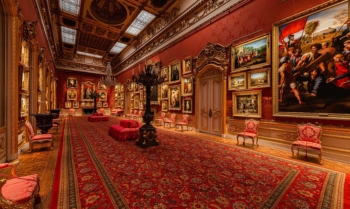Top Tips for Lighting Art
Lighting an artwork properly can transform it. Elaborate fabrics are enriched, complex seascapes are deepened, and gold details gain a lustre, getting as close to the artist’s original intention as possible.
Guest blog post by ‘TM Lighting‘ for Hallett Independent
We have been privileged to illuminate some of the world’s greatest artistic treasures, from Vermeer’s ‘The Guitar Player’ at Kenwood House, to Velázquez’s ‘Waterseller of Seville’ at Apsley House, to Canaletto’s ‘View in London from Richmond House’ at Goodwood, using the latest LED technology to create an unrivalled lighting solution.
We are pleased to be supporting and lighting Curated at Dorfold: British Art Then and Now, with Hallett Independent. The exhibition is a celebration of British Art set in a quintessential British stately home, a Jacobean mansion set in the heart of the English countryside. It opens at Dorfold Hall, Nantwich, Cheshire on 29 January and runs through until 11 February. Having lit the masterpieces at Dorfold, I am pleased to share my advice for how any artwork in the home can be ‘brought to light’ with the right lighting.
1) Prioritise a light source with high colour rendition
Specifying lighting with 95+ colour rendition index (CRI) is important when illuminating the full colour spectrum of a piece of art. Most LEDs do not render the colour red well, so choosing a product with a high CRI will enable the faithful colour rendition of artworks, particularly with colourful pigments and soft skin tones. The higher the CRI, the more colour in a piece of art is revealed.
2) Understand Colour Temperature
Colour temperature is crucial in creating a feeling of warmth in a space, but also must be considered when lighting objects of lighter or darker colours. Metal in particular can be lit with varying colours to achieve different effects. A work containing gold pigments is accentuated with a warmer light (2700K) while a piece dominated by blues or whites would benefit from a cooler light (3000k). These numbers are labelled on light packaging but do take advice from experts for the best results.
3) Consider Consistency
Instructing a reputable manufacturer is one of the best ways to ensure colour consistency from all lights. Works within a diverse collection can easily be brought into a single, consistent scheme by using the same hue of lighting across the collection, and this is most achievable by acquiring lighting from one maker. Ensuring use of consistent LED lighting will unite the display of paintings and objects, making all pieces in a room feel aligned.
4) Use LEDs: Protect the artwork and your budget
LED is an ideal light source for art conservation because it is generally only made up of the visible light spectrum. This minimises harmful ultraviolet (UV) or infrared (IR)light, the cause of significant fading. LED also generally does not produce forward heat, which again is a damaging factor in conservation.
Also, using LED is a far more sustainable and cost-effective lighting option than traditional incandescent art lighting. Measurable energy savings in Watts (W) are clear: an incandescent picture light may use between 30W in a small picture light and 120W in a larger picture light, whereas LED uses 3W and 10W, respectively.
5) Light an artwork evenly
A crucial consideration for lighting any single artwork, whether an Old Master work or contemporary piece, is to create an ‘even wash’ of light over the canvas. An even illumination, achievable with our LED picture lights, ensures an artwork’s details are visible to the viewer as the artist intended. This method does not simply highlight a single part of the work as an unfocussed traditional incandescent light would do.
6) Avoid Reflections
Even with the best anti-reflective glazing, there can still be reflection and glare on artworks.Reflections can be minimised by considering the position of the lighting and the location of the artwork within the room. Consider the main positions where you will view your artwork and always try to ensure that any reflections would not be directly viewed. By placing lighting correctly, visible reflections in artworks can be hugely reduced. Additionally, avoid placing glazed artworks directly opposite large windows.
7) Consider the room’s context when designing a lighting scheme
Lighting is dependent on the artwork and its environment. Balancing which objects are lit and which are not contributes to the atmosphere of a room. It allows the eye to relax and settle on the most cherished works, which should be the ones that are lit.In a classical setting, we recommend using picture lights instead of spotlights. Although both are highly effective at lighting art, using picture lights provides a more precise lighting tool in comparison with spotlights, which can create ‘scallops’ of light above the artwork. In a contemporary environment, there may be more flexibility to use a discreet track and spotlight solution, which is particularly effective if the client has a rolling/curated art collection. Every lighting project is unique, however, and we offer a bespoke service to all clients to suit their personal tastes and selections.
TM Lighting – tmlighting.com




